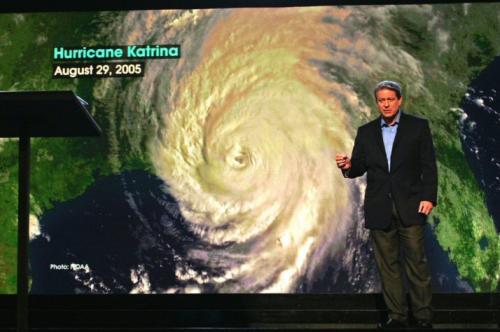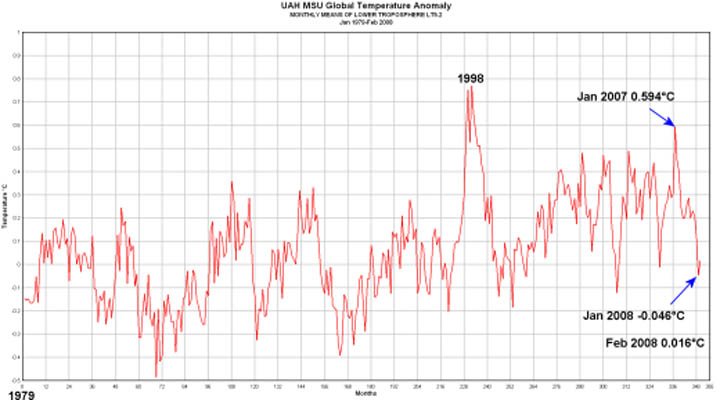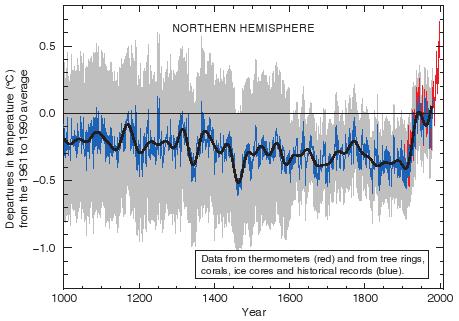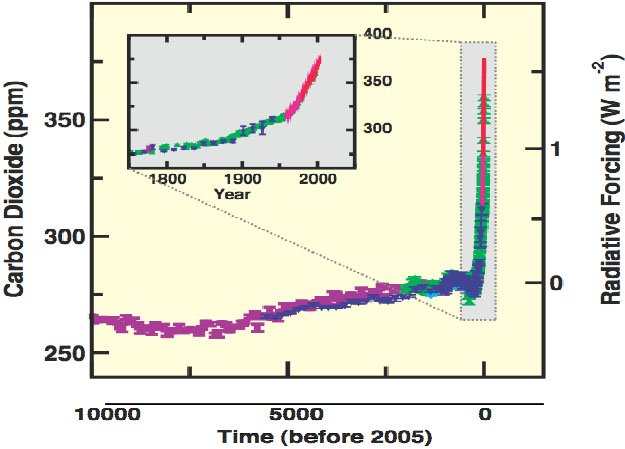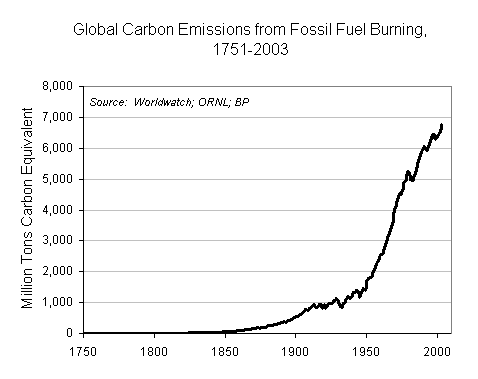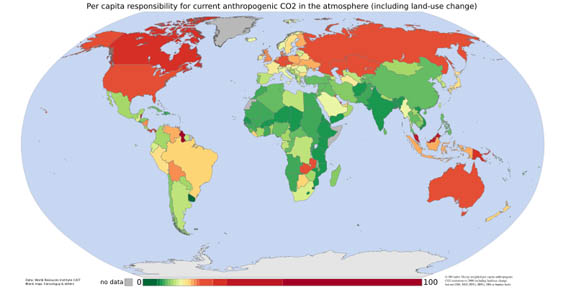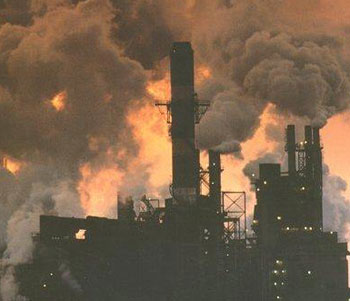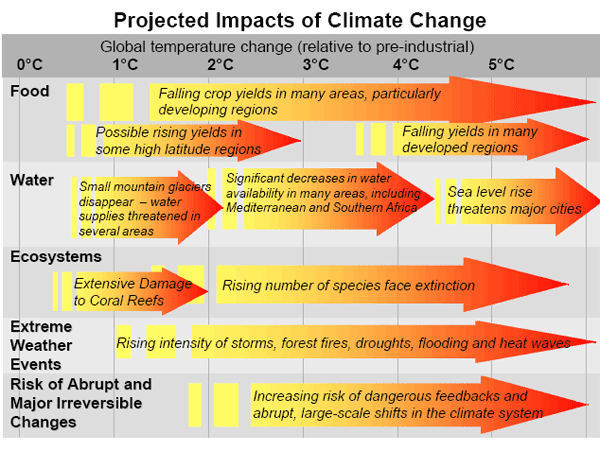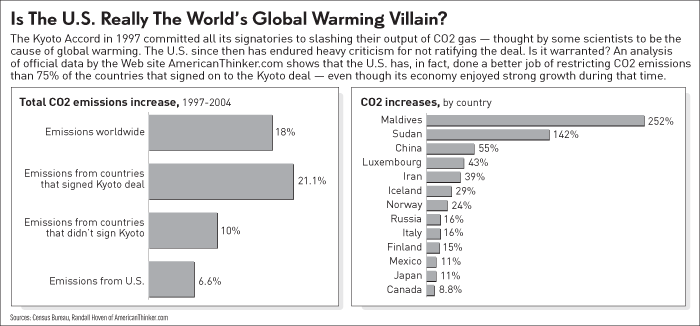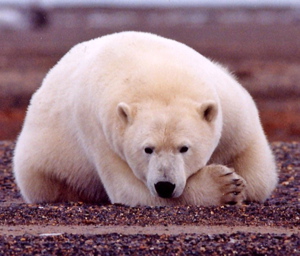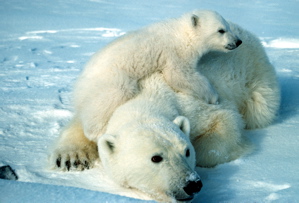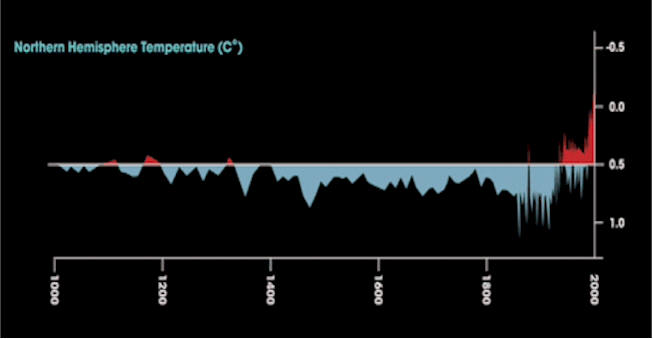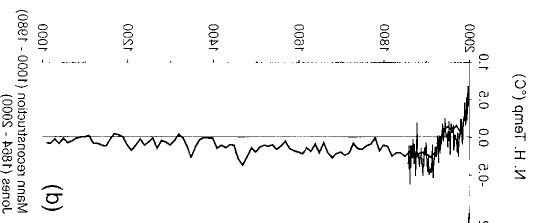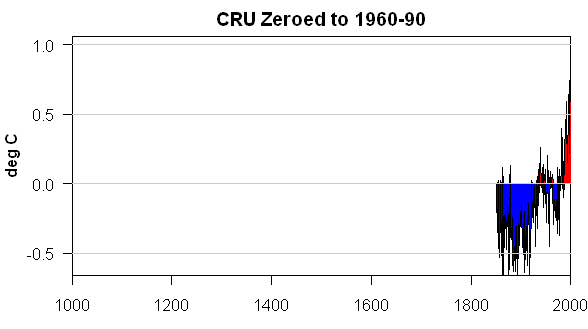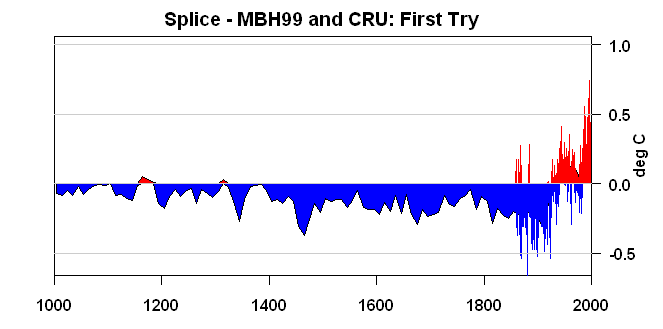|
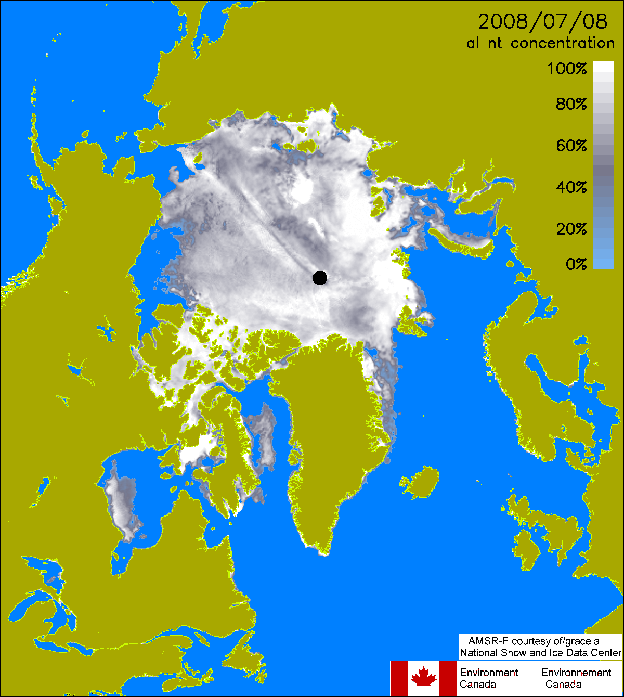
NORTH POLE ICE AT 7-8-08
Arctic Sea Ice Type and Concentration Mapping
Using Passive and Active Microwave Sensors
Walker, N. P.; Partington, K. C.; Van Woert, M. L.; Street, T. L. T.
Geoscience and Remote Sensing, IEEE Transactions on
Volume 44, Issue 12, Dec. 2006 Page(s):3574 - 3584
Digital Object Identifier 10.1109/TGRS.2006.881116
Summary:The mapping of ice type concentrations in
the Arctic is important for commercial operations and for climate-related
research. Algorithms based on moderate-resolution passive microwave
sensors for mapping first-year ice and multiyear ice concentrations suffer
from a number of known problems. In this paper, it has been shown that
QuikSCAT scatterometer data can add complimentary information to that
available from passive microwave, which can assist in separating different
ice classes. Specifically, we identify a class of ice that exhibits a
passive microwave signature which is characteristic of first-year ice, but
has a scatterometer signature which is typical of multiyear ice. We track
the evolution and distribution of this new ice class throughout the Arctic
during the winter season of 2003-2004 and compare the results against the
U.S. National Ice Center (NIC) ice charts. It has been found that the new
ice class is predominantly multiyear ice and is especially prevalent in
the Fram Strait and the high Arctic regions north of the islands Franz
Josef Land and Severnaya Zemlya. A simple algorithm has been proposed that
enables a passive microwave-based partial ice concentration algorithm (for
example, the NT algorithm based on Special Sensor Microwave/Imager data)
to be adapted using QuikSCAT scatterometer data, so that the new ice class
is corrected from the first-year ice class to the multiyear ice category.
The algorithm performance is measured against the NIC ice charts. We
provide a discussion regarding the possible physical causes of the effects
that have been observed and described
FROM:
http://ieeexplore.ieee.org/Xplore/login.jsp?url=/iel5/36/4014302/04014329.pdf?temp=x
|
Gore Sets Bold Energy
Goal for US
By RON FOURNIER
,
AP
WASHINGTON (July 17, 2008) -
Just as John F. Kennedy set his sights on the moon, Al
Gore is challenging the nation to produce every kilowatt of
electricity through wind, sun and other Earth-friendly energy
sources within 10 years, an audacious goal he hopes the next
president will embrace.
The Nobel Prize-winning former vice president said fellow
Democrat Barack Obama and Republican rival John McCain are
"way ahead" of most politicians in the fight against global
climate change.
Rising fuel costs, climate change and the national security
threats posed by U.S. dependence on foreign oil are conspiring
to create "a new political environment" that Gore said will
sustain bold and expensive steps to wean the nation off fossil
fuels.
"I have never seen an opportunity for the country like the
one that's emerging now," Gore told The Associated Press in an
interview previewing a speech on global warming he planned to
give Thursday in Washington.
In his speech, Gore said some of the nation's biggest
success stories have come from making commitments to goals
well beyond the next election, citing the Marshall plan for
rebuilding Europe, Social Security and the interstate highway
system, in addition to putting a man on the moon.
"A political promise to do something 40 years from now is
universally ignored because everyone knows that's
meaningless," he said. "Ten years is about the maximum time
that we as a nation can hold a steady aim and hit the target."
He said it also coincides with experts' predictions that
unless dramatic changes to reduce global warming pollution are
made within the next decade, "our ability to ever recover from
this environmental crisis" may be lost.
Gore said the single most important policy change would be
placing a carbon tax on burning oil and coal.
The Alliance for Climate Protection, a bipartisan group he
leads, estimates the cost of transforming the U.S. to clean
electricity sources at $1.5 trillion to $3 trillion over 30
years in public and private money. But he says it would cost
about as much to build greenhouse gas-polluting coal plants to
satisfy current demand.
"This is an investment that will pay itself back many times
over," Gore said. "It's an expensive investment but not
compared to the rising cost of continuing to invest in fossil
fuels."
Called an alarmist by conservatives, Gore has made global
warming his signature issue. He portrayed Thursday's speech as
the latest and most important phase in his effort to build
public opinion in favor of alternative fuels.
Gore knows politicians fear action unless voters are
willing to sacrifice _ and demand new fuels.
"I hope to contribute to a new political environment in
this country that will allow the next president to do what I
think the next president is going to think is the right thing
to do," Gore said. "But the people have to play a part." He
compared his challenge to Kennedy's pledge in May 1961 to land
a man on the moon by the end of the decade.
Gore narrowly lost the presidential race in 2000 to
then-Texas Gov. George W. Bush after a campaign in which his
prescient views on climate change took a back seat to other
issues. In the 2008 presidential race, both the Republican and
Democrat candidates support action to curb the gases blamed
for global warming.
While dismissing a suggestion that he pulled his punches
eight years ago, Gore said his goal now is to "enlarge the
political space" within which politicians can "deal with the
climate challenge."
To meet his 10-year goal, Gore said nuclear energy output
would continue at current levels while the U.S. dramatically
increases its use of solar, wind, geothermal and clean coal
energy. Huge investments must also be made in technologies
that reduce energy waste and link existing power grids, he
said.
Gore's proposal would represent a significant shift in
where the U.S. gets its power. In 2005, the United States
produced nearly 3.7 billion kilowatt hours of electricity,
with coal providing slightly more than half of that energy,
according to government statistics. Nuclear power accounted
for 21 percent, natural gas 15 percent and renewable sources,
including wind and solar, about 8.6 percent.
Coal's share of electricity generation is only expected to
grow come 2030, according to Energy Department forecasts,
while renewable energy would still only provide 11 percent of
the nation's power.
Without action, the cost of oil will continue to rise as
fast-growing China and India increase demand, Gore said.
Sustained addiction to oil also will place the U.S. at the
mercy of oil-producing governments, he said, and the globe
would suffer irreparable harm.
Government experts recently predicted that, at the current
rate and without an international treaty to reduce greenhouse
gas emissions, world energy demand will grow 50 percent over
the next two decades. The Energy Information Administration
also said in its long-range forecast to 2030 that the world is
not close to abandoning fossil fuels despite their role in
global warming.
While electricity production is only part of the nation's
energy and climate change problem, Gore said, "If we meet this
challenge we will solve the rest of it."
Copyright 2008 The Associated Press.
~~~~~~~~~~~~~~~~~~~~~~~~
AlGore-08.com

Al Gore's 10 point plan to fight global warming
http://www.algore.org/Gores_10_Point_Plan_To_Combat_Global_Warming
Gore's Ten Point Plan
1.) Immediately freeze carbon at
the existing level; then implement programs to reduce it 90% by
2050.
2.) Reduce taxes on employment and
production, instead taxing pollution (especially CO2). These
pollution taxes would raise the same amount of money, but make us
more competitive by encouraging employment while discouraging
pollution.
3.) A portion of the revenues must
be earmarked for low-income and middle class people who will have
a difficult time making this transition.
4.) Negotiate a strong global
treaty to replace Kyoto, while working toward de facto compliance
with Kyoto. Move the start date of this new treaty forward from
2012 to 2010, so the next president can to act immediately, rather
than waste time trying to pass Kyoto right before it expires. We
have to try to get China and India to participate in the treaty.
If they don’t immediately participate, we have to move forward
with the treaty regardless, trusting that they will join sooner
rather than later.
5.) Impose a moratorium on
construction of any new coal-fired power plant not compatible with
carbon capture and sequestration.
6.) Develop an "electranet" -- a
smart grid that allows individual homeowners and small businesses
to create green power and sell their excess power to the utility
companies at a fair price. Just as widely distributed information
processing led to a large new surge of productivity, we need a law
that allows widely distributed energy generation to be sold into
the grid, at a rate determined not by a the utility companies, but
by regulation. The goal is to create a grid that does not require
huge, centralized power plants.
7.) Raise CAFE standards for cars
and trucks as part of a comprehensive package. Cars and trucks are
a large part of the problem, but coal and buildings must be
addressed at the same time.
8.) Set a date for the ban of
incandescent light bulbs that gives industry time to create
alternatives. If the date is set, industry will meet this
challenge.
9.) Create Connie Mae, a
carbon-neutral mortgage association. Connie Mae will defer the
costs of things like insulation and energy efficient windows which
cut carbon but are often not used by builders or renovators
because they add to the upfront costs of homes, only paying for
themselves after several years of energy savings.
10.) The SEC should require
disclosure of carbon emissions in corporate reporting.
|

[Ed. note: This is the first of two guest posts by Katie Carpenter,
a Discovery Hot House producer. Part of the original group
trained
to give Al Gore's 'An Inconvenient Truth' slide show, she
recently
met up with the other climate crusaders to update their
training;
this is her story of the weekend.]
Climate Crusaders Reunite:
Inside Al Gore's Climate Project (Part I)
Nearly a hundred climate crusaders from Al Gore’s
advocacy group,
The Climate
Project, gathered over the weekend in a suburb of
Washington, DC, for two days of meetings designed to
reconnect and retrain them for the climate battles ahead.
They represent the first wave of the “climate
cavalry”, trained in Nashville a year ago by Mr. Gore and
scientists from The Climate Institute. They are now
working across the North East and Mid-Atlantic region,
presenting various versions of Al Gore’s slide show to
schools, churches, conferences and community centers from
Maryland to Maine. I am lucky enough to be one of them.
“We are very proud of you,” said Roy Neel, Al Gore’s
Chief of Staff who flew in to deliver the welcoming
remarks to the group gathered in the Chevy Chase Village
Hall on this unseasonably warm January morning. “You have
given more presentations that Al and I ever thought
possible – to date, more than a million people have seen
that slide show, personally delivered around the world!"
More than a million served. It seems like an amazing
statistic to the group, who are stunned to hear that
there are now 1,700 trained presenters working in a
dozen countries – over a thousand in the U.S. alone –
and that the next big training session is scheduled for
India in March.This all seems kind of unreal.
When we applied for this gig, on an unassuming little
web site set up by The Climate Project and Participant
Productions after the release of the movie “An
Inconvenient Truth”, it seemed like a quixotic dream
that might appeal to only a few hard-cord activists. Al
Gore wanted to train a thousand people to be
communicators for the climate crusade. Most of us
thought he’d have to paper the house.
But as it turned out, they received nearly ten
times that many applications, and those of us who got to
go to Nashville a year ago for the climatology boot camp
are now considered the lucky few. We were trained by the
Gore-acle himself – two hours through the slide show the
first night, twelve hours through it the next day. He
explained the provenance of each and every slide, and
the science behind every fact. Then we spent two days
honing presenting skills, working in small groups into
the night to customize intros and outros to specific
audiences, and learning how to politely deflect
contrarians and skeptics.
New data that strengthens the slideshow is being
compiled and released
constantly; now we have some of it for our shows.
Now we’re at the first-ever regional trainees
reunion, and the all-stars are here to bring us up to
date, teach us the new science, offer locally specific
solutions slides, show us how to use Google maps and
data from the Web site of new science partners like the
Union of Concerned
Scientists. And not a moment too soon -- a recent
article in the
Washington Post stating that 2007 has just
been determined to have been the second-warmest year on
record. Ever.
It’s been a daunting year, frankly -- the news has
been nothing but bad. Extreme weather, increasing fires
and droughts, disappearing species. They know that we
need to be re-energized, so they offer us a new science
adviser, Jeremy Richardson, a freshly minted PhD., who
will give us the new information we need so badly. Many
of our audiences get impatient and clamor for solutions
– Jeremy is here to explain the options to us, and also
to make sure we are all on track in terms of accuracy
every time we give the slide show.
We are not scientists. We are priests and teachers
and mayors and professional athletes and country-western
singers and software programmers and just plain folks,
and the science can get pretty deep out there in the
trenches when the nay-sayers jump up in the back of the
room and scream that Antarctica is actually cooling, so
global warming must be a hoax perpetrated by liberals!
So Jeremy and the other science advisors to The
Climate Project are here with the data to re-focus us
and make sure we get the story right – fearlessly and
confidently, without backing down.
“We know you guys are modifying and updating the
slide show – we know you have to,” says Roy with a
smile. “People don’t want to see the movie over and over
again, they need the new information and they need the
solutions-based slides, we know, and we thank you for
your resourcefulness. But as you know, you cannot just
grab anything off the Web and put it in your slide show,
make sure you get it right.” So this retraining session
is a critical opportunity for us – we can share our new
solutions-based slides, update them and fact-check them,
and The Climate Project scientists have new,
peer-reviewed information to share with us. And we have
a couple of amazing mentors – called District Managers –
who guide us through the technical bits.
So as we pass our flash drives from laptop to
laptop, exchanging PowerPoint presentations and Keynote
slides and individual images of glaciers calving and
storms raging, and new graphs showing how much we are
still emitting huge quantities of carbon even though it
seems like progress is being made. There’s a slide from
the IPCC (Intergovernmental Panel on Climate Change)
report which is now famous among presenters as the
“burning embers” slide – a graph that shows how public
opinion on this is slowly but finally changing, but
probably not fast enough. It’s a call to action – we’ve
all got to work harder, faster, go farther, now!
Katie will be back tomorrow with the
conclusion of her weekend of climate presentation
training; stay tuned!
From:
www.treehugger.com
|
|
"ALLIANCE FOR CLIMATE PROTECTION"
The Alliance for Climate Protection
is an organization in the
United States aiming to 'persuade people of the importance,
urgency and feasibility of adopting and implementing effective and
comprehensive solutions for the
climate crisis'. The founder and current chairman of the
alliance is former US Vice President
Al Gore.
The Alliance is a member of Save Our
Selves, the organizers of the July 2007
Live Earth concerts.
According to the organization,
research in January 2007 indicated that while 77% of Americans
believe that there is solid evidence that the Earth is warming, only
47% understand its link with
human activity. The Alliance believes that explaining this link,
and motivating people to take action, is the organization's key
challenge.
Funding
Paramount Classics, distributor of
Gore's documentary An Inconvenient Truth announced in August
2006 that it would donate 5% of all box office receipts to the
Alliance. Al Gore is also donating all his proceeds from the film to
the Alliance.
Some of the profits from the
Live Earth concerts, and profits from the associated book -
The Live Earth Global Warming Survival Handbook, will also be
used to fund the alliance, which is also seeking contributions from
other donors.
Prior to launch it was expected that
more than 60% of the funding will be used for 'national and local
media projects aimed at mass persuasion', with the rest used to
support grassroots groups and institutions that educate the public
about
climate change.
LINKS and REFERENCE
-
Alliance for Climate Protection -
Official site
-
About the Alliance, The Alliance for Climate Protection,
accessed 2007-07-03
-
The Challenge The Alliance for Climate Protection,
accessed 2007-07-03.
-
Paramount Classics To Donate An Unprecedented One Million Dollars
To Fight Global Warming. Climatecrisis.net (2006-08-04).
-
Live Earth switch-off is vetoed,
BBC,
published 2007-06-04, accessed 2007-07-03
-
The Live Earth Global Warming
Survival Handbook: 77 Essential Skills To Stop Climate Change,
author: David de Rothschild, publsisher: Rodale Books, ISBN:
159486781X
-
Rodale Books to publish the official Live Earth Global Warming
Survival Handbook, Live Earth, published 2006-05-16
-
Gore-backed group will spend big to convince Americans climate
change is real grist.org, published 2006-05-19,
accessed 2007-07-03
-
www.Change.org
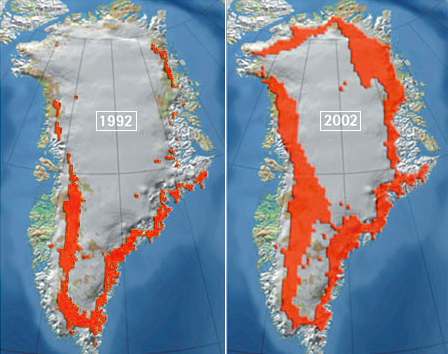
Greenland ice
sheet melt extent
FROM;
http://www.solarnavigator.net/alliance_for_climate_protection.htm
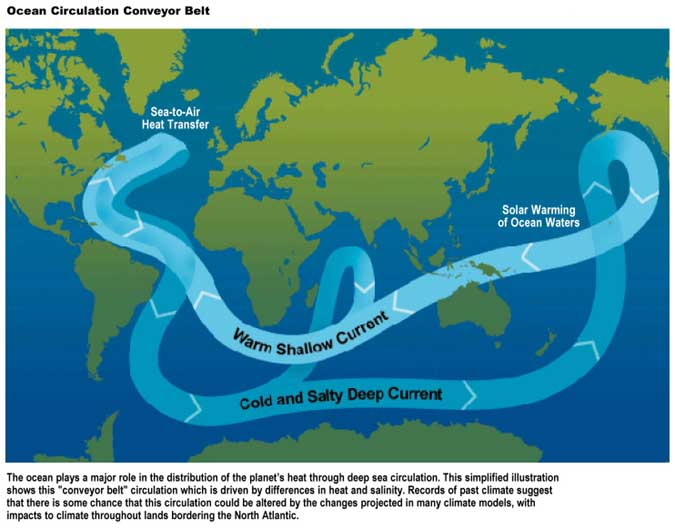
http://www.ncdc.noaa.gov/paleo/ctl/images/belt.jpg
|
The Environment, Politics, and Religion
2008
Climate Change Explained
What is climate change? Why’s everyone getting all huffy about a
tiny change in the temperature of the Earth? Doesn’t it all seem
just a little bit silly?There’s a good chance that, if you’re
reading my blog, you’re already somewhat familiar with the basics of
climate change. But maybe when you’re sitting around, talking with
your friends or family, they ask you questions that you don’t know
the answer to: ”It was the coldest winter here in fifteen years!
How can global warming be happening?”, “There’s no scientific
consensus on global warming! Fox News said so!”, etc.
So, for your benefit and review, here’s my little guide to
Climate Change. There’ll be some resources at the end for further
reading, in case you’d like them. Also, if you’re new to climate
change, or if you’re a skeptic, please keep an open mind as you
read; the only way you get anything out of anything is by going in
with a positive attitude.
In any case, let us begin with:
A BRIEF OVERVIEW OF THE RECENT
HISTORY OF OUR PLANET
In order to really understand climate
change, we have to take a look at how the Earth has worked for the
past few million years. Right now, we’re living in what scientists
call the Quaternary Period, a period of geologic history that began
about 1.6 million years ago. In geologic time, that’s not too old;
considering the fact that the planet was formed about 4.5 billion
years ago, the Quarternary Period is relatively short.
Also, it’s important to note that we are
living in an Ice Age. The Quarternary Period is relatively cold
compared to other time periods, and during the last 1.6 million
years, the ice caps have been constantly growing and shrinking,
expanding and contracting. (The ice caps go all the way from the
point at which they are now, all the way down to Seattle! Imagine a
five mile high glacier in the middle of downtown Seattle…crazy.)
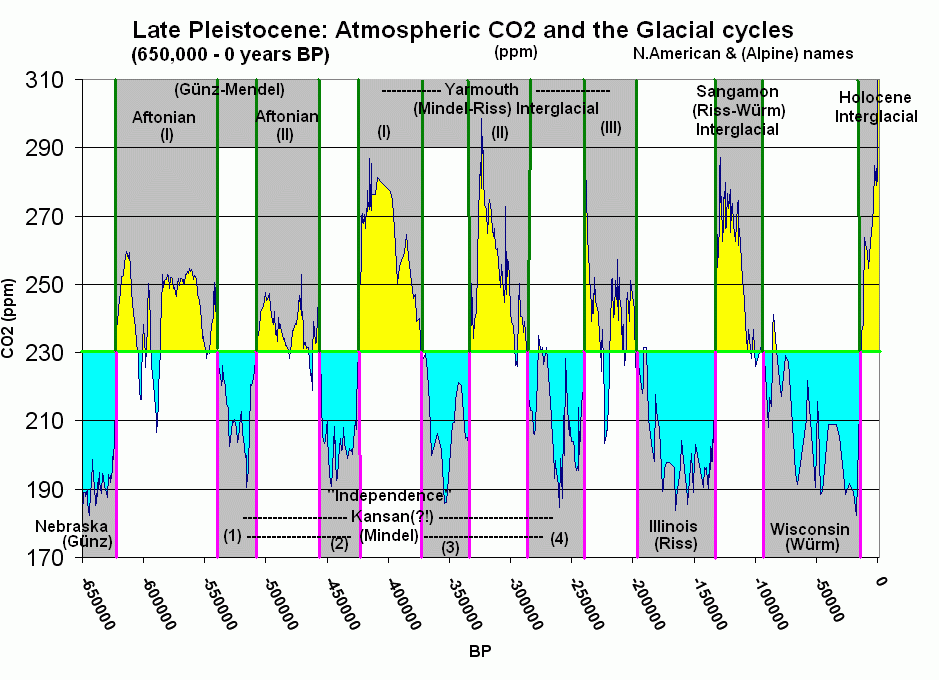
So, if we look at the graph above, we
can notice a few things. One is that the graph begins about 650,000
years ago and charts time on the y-axis, and another is that the
graph charts the parts per million (ppm) of CO2 in the atmosphere.
That’s on the x-axis. Also, you’ll notice that the lines charted on
the graph go up and down, in cycles.
Scientists note that the times when
we’ve had lots of glaciers covering the surface of the Earth are the
same times that there has been a relatively small amount of CO2 in
the atmosphere (look at the graph: see how the blue areas, which
are the times representing glacial periods, are all times during
which the amount of CO2 in the atmosphere is below 230 ppm?). Also,
they notice that the exact opposite is true: the times when there
have been few glaciers, called “interglacial periods,” have had
relatively high amounts of CO2 in the atmosphere (the times outlined
in yellow).
So we can clearly see that the amount of
CO2 in the atmosphere can at least somewhat account for changes in
climate. When there’s a low amount of CO2 in the atmosphere, we’re
going to have a period of really cold temperatures and glaciers;
when there’s a high amount of CO2 in the atmosphere, we’re going to
have an interglacial period with relatively fewer glaciers and
warmer temperatures.
So, do you think we live in an
interglacial period, or a glacial period? If you guessed
interglacial period, you are correct! We’re smack in the middle of
what’s called the Holocene, an interglacial period that began around
9600 BC, so the levels of CO2 in the atmosphere are naturally higher
than what they are during a glacial period.
Looking back at the graph, we have to
notice two more things. First, notice the variation in levels of
CO2. The lowest amount of CO2 we’ve had is probably around 180, and
the highest CO2 we can see is about 290, or perhaps a bit above
300. But generally, the amount of CO2 in the atmosphere has
remained in a comfortable space of between 190 and 290.
The last thing we see when we look at
that graph is the amount of time that it takes for CO2 levels to
change. The changes in temperature and in the amounts of CO2 take
place over thousands of years, sometimes even tens of thousands of
years. That’s a long time!
Now that we have seen how the Earth has
behaved in the past, and can see the patterns and cycles that have
occurred naturally on account of CO2 levels, let’s move on to:
HUMANS BEGIN TO USE FOSSIL
FUELS, AND CO2 LEVELS RISE
In the nineteenth century, a curious
phenomenon began to occur on our planet. Humans had discovered the
power of fossil fuels (coal, oil, natural gas, and a few others),
and the CO2 levels in our atmosphere began to increase dramatically.
Let’s take a look at a graph from the
IPCC, the Intergovernmental Panel on Climate Change. (They’re the
2,000 or so scientists that recently won the Nobel Peace Prize along
with Al Gore for their work studying global warming, and the effects
global warming has on our climate.)

This graph is almost identical to the
first graph we looked at, but instead of looking at 650,000 years,
this one above only graphs C02 levels from the past 10,000 years.
So, the y-axis charts time, from about the present to 10,000 years
ago. This amount of time covers just about the entire Holocene
period. The x-axis charts the parts per million (ppm) of CO2 in the
atmosphere, just like first graph. Also, in the right hand corner,
the scientists have taken the past two hundred years and made an
additional graph. It’s the same thing: time on the y-axis, CO2 in
ppm on the x-axis, except the chart is dealing with an even
smaller amount of time than the big graph it’s sitting on.
Pretty cool.
Now, do you notice anything
interesting? It’s pretty obvious. Look at how quickly the amount
of CO2 in the atmosphere rose starting in the last two hundred
years. On the big graph, it’s almost a vertical line that just
shoots straight up, from about 280 ppm of CO2 to about 375 ppm of
CO2. Whoa! That’s pretty fast, isn’t it?
Think about the first graph that we
looked at. Remember the interglacial periods and the glacial
periods? Remember how in order to create these two vastly different
environments, it only took a fluctuation of CO2 levels in between
190 and 290 ppm? And remember how these fluctuations and cycles
took place over thousands of years?
Wow. Now look at our newest graph. The
amount of CO2 in the atmosphere is the highest it’s been in the last
650,000 years, to what looks to be about 375 ppm, or 85 ppm more
than what’s normally the highest! Even more astonishing is the fact
that this amount of CO2 was put in the atmosphere in less than two
hundred years, not the thousands of years that is considered
typical. If we were to graph 375 ppm on the first graph we looked
at, it would be literally off the charts.
So, now we can clearly see that there is
a lot more CO2 in the atmosphere than is normal. “Okay,” you may be
thinking, ”why does that matter?”
Good question. Now is when we must ask:
DO RISING CO2 LEVELS RESULT IN
GLOBAL WARMING?
Scientists often use computer models to
figure out how the climate acts, or would act given certain
conditions. Since we don’t have another planet Earth to mess around
with, we use climate models to create scenarios we can use to tell
the differences between what’s going on and what would be going on
if we didn’t have a certain factor affecting climate.
So, for instance, we could construct a
climate model that would show what would happen if there were no
human-created (or, “anthropogenic”) CO2 emissions that got into the
atmosphere. That would give us a model of the temperature of the
planet without anthropogenic CO2 levels interfering, which we can
think compare to our current, real life world temperatures.
And luckily for us, scientists have done
just that.

This graph shows in gray the results of
the model. The y-axis graphs the average global temperature (in
degrees Celsius), and the x-axis graphs time from 1850 until 2000.
The gray area is what the climate model predicted would be what
happened if there were no anthropogenic CO2 levels affecting the
temperature, whereas the red line shows the real temperature
data recorded since 1850.
Hmm…they don’t seem to match up too
well, do they? Notice especially how the red and gray really start
to diverge starting in the 1960s and ’70s. If the two graphs
matched up, we could say positively that our climate is acting
naturally, without being affected by humans. But the graphs don’t
match up very well at all.
Looking at this graph, we can now be
sure that whatever is happening to our climate is not
natural. Things would not be acting the way they are if it were
happening naturally. So now we ask ourselves, “What could be the
cause of the sudden increase in temperatures?”
Well, to answer that question, we can
create another climate model, but this time, we’ll include only
anthropogenic sources of CO2. Then we’ll take that model and see
how it matches up to the real life data.

The graph is the same as the one
directly above, and the only thing that has changed is the model
results (the gray). Interestingly, the gray seems to be matching up
with the red a little bit more, doesn’t it? In the first model that
was made, the red line seemed to jump way above the gray line once
we hit the 70s, but in this graph, the red line seems to be sitting
right on top of the gray line for a good part of the graph.
So, it seems to fit that anthropogenic
CO2 is causing warming. But just to be sure, let’s look at a model
that combines the data from both natural and anthropogenic CO2
sources.

Whoa! Notice how perfectly the lines
seem to match up. This model is by far the most accurate of any of
the other two. Thus, it seems that we can accurately say that
humans have caused the global temperature to go up, and that this
was more likely than not caused by the amount of CO2 we’ve been
releasing into the atmosphere.
Conclusion
These are just some of the data that are
available out there. If you’d like to learn more, I’d strongly
suggest that you check out the IPCC (Intergovernmental Panel on
Climate Change). They are the major authority on climate change and
global warming. Their latest report came out in 2007, and the
summary for the scientific data can be found here:
http://www.ipcc.ch/pdf/assessment-report/ar4/wg1/ar4-wg1-spm.pdf
Also, if you’re a climate skeptic who
still doesn’t think global warming and climate change could be
possible, take a look at Grist Magazine’s guide to climate change:
http://gristmill.grist.org/skeptics
Thanks! And if you’ve got ideas for
more information to add, please let me know.
|
Gore hits at US over climate
change
By John Aglionby in Nusa Dua, Bali and agencies
Published: December 13 2007
Al Gore savaged the US government’s “obstructing” attitude and
urged delegates at the UN conference on climate change to
ignore Washington if necessary to pursue the “moral
imperative” of a new global regime.
“My country is principally responsible for obstructing
progress here in Bali,” the former US vice-president told
2,000 of the 12,000 people attending the conference on
Thursday. “[But] over the next two years the United States is
going to be somewhere it is not now.”
*************
Global Carbon Tax Urged at UN Climate Conference
BALI, Indonesia – A global tax on carbon dioxide emissions was
urged to help save the Earth from catastrophic man-made global
warming at the United Nations climate conference. A panel of
UN participants on Thursday urged the adoption of a tax that
would represent “a global burden sharing system, fair, with
solidarity, and legally binding to all nations.”
“Finally someone will pay for these [climate related] costs,”
Othmar Schwank, a global tax advocate, told Inhofe EPW Press
Blog following the panel discussion titled “A Global CO2 Tax.”
Schwank is a consultant with the Switzerland based Mauch
Consulting firm
Schwank said at least “$10-$40 billion dollars per year” could
be generated by the tax, and wealthy nations like the U.S.
would bear the biggest burden based on the “polluters pay
principle.”
The U.S. and other wealthy nations need to “contribute
significantly more to this global fund,” Schwank explained. He
also added, “It is very essential to tax coal.”
The UN was presented with a new report from the Swiss Federal
Office for the Environment titled “Global Solidarity in
Financing Adaptation.” The report stated there was an “urgent
need” for a global tax in order for “damages [from climate
change] to be kept from growing to truly catastrophic levels,
especially in vulnerable countries of the developing world.”
The tens of billions of dollars per year generated by a global
tax would “flow into a global Multilateral Adaptation Fund” to
help nations cope with global warming, according to the
report.
Schwank said a global carbon dioxide tax is an idea long
overdue that is urgently needed to establish “a funding scheme
which generates the resources required to address the
dimension of challenge with regard to climate change costs.”
'Diminish future prosperity'
However, ideas like a global tax and the overall UN climate
agenda met strong opposition Thursday from a team of over 100
prominent international scientists who warned the UN that
attempting to control the Earth's climate was "ultimately
futile."
The scientists wrote, “The IPCC's conclusions are quite
inadequate as justification for implementing policies that
will markedly diminish future prosperity. In particular, it is
not established that it is possible to significantly alter
global climate through cuts in human greenhouse gas
emissions." The scientists, many of whom are current or former
members of the UN Intergovernmental Panel on Climate Change (IPCC),
sent the December 13 letter to the UN Secretary-General. (See:
Over 100 Prominent Scientists Warn UN Against 'Futile' Climate
Control Efforts – LINK)
‘Redistribution of wealth’
The environmental group Friends of the Earth, in attendance in
Bali, also advocated the transfer of money from rich to poor
nations on Wednesday.
“A climate change response must have at its heart a
redistribution of wealth and resources,” said Emma Brindal, a
climate justice campaigner coordinator for Friends of the
Earth.
***************
A bureaucrat's dream'
MIT climate scientist Dr. Richard Lindzen warned about these
types of carbon regulations earlier this year. "Controlling
carbon is a bureaucrat's dream. If you control carbon, you
control life," Lindzen said in March 2007. (LINK)
In addition, many critics have often charged that proposed tax
and regulatory “solutions” were more important to the
promoters of man-made climate fears than the accuracy of their
science.
Former Colorado Senator Tim Wirth reportedly said in 1990,
"We've got to ride the global warming issue. Even if the theory of global
warming is wrong, we will be doing the right thing — in terms of economic policy
and environmental policy."
(LINK)
|
|
FROM:
www.climateaudit.org/?p=2335
|
|
An INTERVIEW with Al Gore’s Climate Project
By Todd | October 5, 2007
In June 2006, Al Gore’s
The Climate Project (TCP) began operations
with the mission of increasing public awareness of the climate
crisis at a grassroots level throughout the United States and
abroad.
By April 2007, hundreds of public speakers across the U.S. had
been trained to present a version of the slide show on which the
Academy Award-winning film, “An Inconvenient Truth” is
based.
We are grateful to have with us today David R.
Fried, one of the original presenters to go through the
TCP program. “David Fried is an outstanding example of the millions
of Americans who have been energized by the call to action on the
climate crisis,” said Al Gore.
Since completing the program David has become a sought after
speaker on global warming issues, and lectures throughout southern
CA and anywhere the mission takes him.
—David, thank you for agreeing to share your
knowledge with the We The Change audience. Tell us what was entailed
to become a TCP speaker?
Most of the training consisted of Al Gore going through slide
by slide the full scope of material contained in the movie (and
book)
An Inconvenient Truth. The course provided
us with a baseline of knowledge to speak intelligently about the
most pressing issues in global warming. It was VERY intense.
—How much of an environmental “crisis” are we
really in?
You know, one of the things we talked about is how the symbol
for crisis in Chinese also stands for “opportunity”. Meaning,
no matter how bad it may seem right now we still have the
ability to make the necessary changes! With that said,
if left unchecked there is no doubt that certain aspects of the
environment are in peril. The mass introduction of Carbon emissions
over the last 30-50 years has caused dire environmental
consequences. If we extrapolate current CO usage another 50 years
(which is like the blink of an eye in terms the “earth” time) there
is no telling the environmental damage that can incur. While the
change seems slow and gradual for us in our short lifetimes, it is
happening at nano-speed in the earth’s timeline!

— Can you briefly explain what you mean by “Carbon
emissions” and how they affect global warming?
Many chemical compounds found in the Earth’s atmosphere act as
“greenhouse gases.” These gases allow sunlight to enter the
atmosphere freely and when sunlight strikes the Earth’s surface,
some of it is reflected back towards space as infrared radiation
(heat). Greenhouse gases absorb this infrared radiation and trap the
heat in the atmosphere.
Assessments generally suggest that the Earth’s
climate has warmed over the past century and that human activity
affecting the atmosphere is likely an important driving factor.
Some of the main sources of greenhouse gases due to human activity
include burning of fossil fuels and deforestation leading to higher
carbon dioxide concentrations. In the U.S., our greenhouse gas
emissions come mostly from energy use.

—What 5 or 6 simple actions can EVERYONE do to begin
offsetting damaging CO emissions?
1. Turn the lights off when leaving home—anybody can do that.
2. Shop with a cloth bag instead of using plastic bags (which use
petroleum to produce)—anybody can do that.
3. RECYCLE—anybody can do that!
4. If you are a multiple car family, use the car with the best gas
mileage—anybody can do that.
5. Turn your hot water heater down (or off) when not in use—anybody
can do that.
6. Make sure you run full loads of laundry and in the
dishwasher—anybody can do that.
7.
Read my list of 76 things you can do and
Watch (or read) An Inconvenient Truth!
These actions all come under the category of “intelligent
efficiency” AND they save you money!
— Are there any beneficial web resources that you can
recommend?
The
Carbon Fund is a wonderful web resource that
everyone should go to. On the site, you can determine what your
personal carbon emissions are (based on how much you travel, where
you live, etc…). And you can make contributions to offset these
emissions, which I believe are tax-deductible (but check with your
CPA). The funds go towards building more sustainable energy
resources, and to the promotion of these practices.
Next, you can go to
Arbor Day
or
American Forest websites and help plant
trees or buy a piece of the rain forest to prevent it from being cut
down. Another great thing to do is go the the
EPO website and find a local energy
supplier who uses green energy. Its easy and will do the environment
a lot of good!
—What are the next steps for The Climate Project?
You can go to
The Climate Project website and apply to
become a presenter, or you can request a presenter (like me) to
speak for your organization. The heart of The Climate Project lies
in the commitment, dedication and passion of TCP presenters to
educate, encourage and increase dialogue about the climate crisis
and its solutions. SO getting more people involved is the next step
for TCP, and the most crucial component of making global change!
David thank you for being here today, it has been
enlightening. When it comes to the global warming issue, we really
ARE the change.
http://www.wethechange.com/an-interview-with-al-gores-climate-project/
|
 The award winning UN Climate Panel that took home this
year’s Nobel Peace Prize (along with Al Gore) hopes to look
towards the mysteries of Greenland. After three successive
overall reports, released in 1995, 2001 and 2007, the panel
may look towards more specific research targets.
The award winning UN Climate Panel that took home this
year’s Nobel Peace Prize (along with Al Gore) hopes to look
towards the mysteries of Greenland. After three successive
overall reports, released in 1995, 2001 and 2007, the panel
may look towards more specific research targets.
One of these is the effect a thaw of the Greenland
ice-sheet could have upon the world.
Dutch scientist Bert Metz, a senior member of the
panel, said that the risks of an accelerated ice-melt in
Greenland were among the unsolved issues in the most recent
report. “There are still questions about the behavior of the
big ice sheets, like Greenland, and the consequences of sea
level rise,” he told Reuters.
One of the major issues that have recently been
brought to scientist’s attention is the risk of great chunks
of the Greenland ice-sheet falling in to the ocean. This
poses problems unlooked for, compared to a slow melt of
surface ice.
Recent research conducted in Antarctica has shown the
terrible effects caused by global warming. Instead of a
runoff in to the ocean the ice-melt acts like droplets of
acid on paper; they work their way down through the
ice-sheet and pool beneath it. This not only degrades the
integrity of the sheet, but provides lubrication. The end
result, as witnessed on the Antarctic Peninsula recently, is
a massive break off of ice in to the surrounding waters.
The UN Intergovernmental Panel is currently awaiting
the OK from their governments, for funding for new research
projects. “There are voices that say we should postpone a
global overview a bit and in the meantime do more focused
special reports,” said Metz, who will be one of the 25 to
receive the Nobel Peace Prize awarded on December the 10th.
The reports conducted by the IPCC believes that
sea-levels will rise between 18 and 59 centimeters (7-23
inches) this century alone, but they do not take into
consideration an accelerated Greenland melt, nor a melt of
large areas of Antarctica, which is much less likely.
A few years ago “we thought a thaw of Greenland might
happen but it would take thousands and thousands of years —
‘this chunk of ice will melt gradually from the outside’,”
Metz said. “But now the latest information is that there may
be different mechanisms, of water going down into crevasses
and acting as a lubricant” beneath large areas of ice, he
said.
The main risk, even greater than an unexpected rise of
sea levels, is the effect such an event could have on the
Gulf Stream.
At the end of the last ice-age when the North American
Laurentide ice sheet retreated northwards, it left behind a
great pool of freshwater. This inland ocean was the
formation for the Great Lakes, but not until a great
majority of the water spilled out in to the North Atlantic.
The influx of freshwater stopped the Gulf Stream, which
caused a brief cold period for Europe known primarily as the
Younger Dryas.
The threat at hand today is that an influx of
low-salinity water from chunks of ice off the Greenland
ice-sheet could once again cause problems for the Gulf
Stream. This could create a pocket-cooling across Europe,
while the rest of the planet warms.
The latest IPCC report states that such a shutdown of
the Gulf Stream is “very unlikely” but that the risks beyond
that eventuality cannot be confidently reckoned.
Reuters via ENN -
Greenland ice could be next puzzle for U.N. panel
|
Joint attack on climate change
and poverty needed, Al Gore tells audience at UN
24 September 2007 – A new Marshall
Plan is needed to simultaneously tackle global warming and poverty,
the environmental activist and former United States Vice-President Al
Gore told an audience at United Nations Headquarters in New York
today.
“We now face a global crisis that makes it abundantly clear that
increased carbon dioxide emissions anywhere are a threat to the
integrity of this planet’s climate everywhere,” Mr. Gore told a
luncheon event called “Global Voices on Climate Change.”
The event, hosted by Denmark, Indonesia, Kenya and Poland, was
held on the sidelines of the largest-ever gathering of world leaders
on climate change.
Increased emissions are responsible for rising temperatures and
rising sea levels, which combine to elevate both food and water
insecurity worldwide, Mr. Gore said.
“The old divide between North and South, between developed and
developing, is now obsolete,” he told the event’s participants, who
included 40 heads of State or government, nine deputy prime ministers
and vice presidents and 70 cabinet ministers from all over the world.
“We must link poverty reduction with the sharp reduction of
carbon dioxide emissions,” he noted, calling for a plan of attack like
that of the Marshall Plan, the post-World War II European
reconstruction initiative of the US – to tie the struggles against
climate change and poverty.
Mr. Gore also urged the completion of the negotiations for
creating the successor to the Kyoto Protocol – the current global
framework for reducing greenhouse gas emissions which will expire in
2012 – by 2009.
“We simply cannot wait longer,” he said, calling on heads of
state to convene meetings every three months until a post-Kyoto treaty
is agreed upon.
“We cannot continue business as usual,” he added. “We cannot
continue at a slow pace.”
http://www.un.org/apps/news/story.asp?NewsID=23942&Cr=climate&Cr1=change
|
UN climate panel says emissions quotas insufficient—focus
should lie on industry
The third report issued by the
UN Climate Panel concludes that emissions quota trading schemes
alone are insufficient to reduce greenhouse gasses by 50 to 80
percent over the next 50 years, and said instead that nations
should focus efforts to develop new environmentally friendly
technologies and make them marketable.
Anne Karin Saether,
Charles
Digges, 14/05-2007
Such a scheme to develop and market these new technologies,
the report asserted, should be accomplished by a series of
government subsides, legislation, duties and taxes, and binding
agreements.
Emission trading schemes, such as those available under the Kyoto
Protocol, the Climate Panel report argues, are insufficient to
stem the growth of greenhouse gases.
The Bellona Foundation is entirely in agreement with the
conclusions drawn by the UN Climate Change panel in its latest
report, and has long been lobbying for many of the tasks the
Climate Report puts before governments in the interest of reaching
an emissions free energy economy and society.
Trading schemes are typically designed to set national or business
caps on greenhouse gas emissions. Businesses or nations that
produce more than their allocated amount of emissions are able to
purchase so called “carbon credits” from businesses or nations
that are producing green house gasses below their set emissions
cap.
The Climate Panel’s reports
The Climate Panel’s third report entitled “Mitigation of Climate
Change” was made public on May 4th, and is one part of the panel’s
four-part series on climate change issue. This most recent report
discusses each emissions reduction effort currently underway in
each energy sector and analyses their short term, medium term and
long term Impact on the climate and society.
It also highlights each remedy that has the best record so far and
thoroughly backs carbon capture and storage as an applicable
technique to limit emissions.
Previous installments of the report have included the assertion,
in its first volume, that climate changes are man-made. This
release was the most jarring and detailed analysis of its kind to
date, and followed quickly on the heels of the thunderous reaction
to the British Stern Report, which had reached the same conclusion
that global climate change was man-made.
The Climate Panel report’s second installment, released in April,
pointed out the catastrophic consequences that climate change
would have for nature and society. This, too, confirmed the
findings of the Stern report, which concluded that climate change
would have as devastating an impact on the global economy and
society as the two World Wars.
This most recent installment from the UN Climate Panel focuses on
what can be done to reduce global climate change. Its central
thesis is that it is necessary to induce industry to reduce
emissions—but warns that this must be done quickly.
UN warmly endorses carbon capture in
third release
The first (UN Climate Panel) report was monstrously frightening,”
said Bellona President Frederic Hauge. “This last one shows that
we can actually do something—without having to stop eating meat or
go visit our grandmothers. We are especially pleased with (the
report’s) wide acceptance of carbon capture and storage, which
will bring us a long way down the road.”
Carbon capture and storage- long a controversial question in
environmental circles—is an initiative that has long been
encouraged by Bellona, as its technology is something that can be
applied as an upgrade to emissions releasing plants that already
exist.
Specific areas targeted
The UN Climate Panel shows there is enormous potential to reduce
emissions and greenhouse gases especially within the energy,
construction, industry and agricultural sectors.
The UN Climate Panel called for an increase in energy efficiency
within energy production, an emphasis on renewable energy and
emphasised the importance of carbon capture and storage at
factories, the report said.
There are number of efforts that can be undertaken within the
transport sector, starting with bio-fuels and expended public
transportation, the report indicated. Despite the myriad obstacles
in this sector, there are also wide and critical possibilities
toward reducing emissions. Yet market influences alone, including
higher fuel prices, will not yield significant emissions
reductions, says the report.
As concerns construction, the report asserted, an increase in
energy efficiency could critically reduce the price of emissions.
Construction, said the report, could forgo more than 30 percent
its emissions by applying a few efforts that would pay for
themselves.
Industry, the report said, holds the most potential by upgrading
ineffective industries in both poor and rich nations. Energy
reclamation and carbon capture and storage in the cement,
fertilizer and metal industries would be a good measure, says the
report.
Subsidies demnaded for new technology
In order to enact these changes, the report conceded, expensive
government subsidies must be applied, Yet the report emphasised
that subsidies are critically needed to overcome barriers to
implementing new technologies.
“This is in step with Bellona’s assessment—environmentally
friendly fuel for cars, carbon dioxide cleansing, and solar energy
are examples of solutions with big potential, but as always will
not come into play without help from the authorities,” said
Bellona co-chairman Marius Holm.
“These are solutions that will be expensive at first glance, but
which must prevail over technical and economic barriers. Even if a
method may seem expensive today, using the Kyoto Protocol as a
yardstick, methods that promote totally clean energy will be cost
effective in the long run.”
Carbon prices lay the foundation
The Climate Panel recommends the introduction of a “price on
carbon.” This means in practice the introduction of a world-wide
carbon dioxide market.
Where the Kyoto Protocol aims for reducing world wide emissions to
the levels recorded in 1990 by 2012, the carbon dioxide market
goes further by fixing a price tag to emissions, and pushing for a
constantly lowering ceiling for emissions.
“Bellona supports the notion of a global quota system where the
overall emissions ceiling gradually comes down. When all carbon
dioxide emissions receive a cost, the market will trigger a large
spectrum of simple and cheap efforts that will constitute large
emissions reductions,” said Holm.
Holm added that Bellona was “relieved” that the Climate Panel had
reached the same conclusions as the organisation, especially
concerning carbon pricing and that it is not sufficient by itself
to yield the desired emissions cuts.
< by itself and it won’t happen even if quota
prices are high because these (new energy) solutions must gather a
large momentum before they become competitive,” said Holm.
Large spectrum of methods evaluated
The third installment of the Climate Report examines an exhaustive
amount of alternative energy methods for each specific energy
sector.
Experience from many countries attests to the fact that all
methods have their advantages and disadvantages, the report points
out, and determines, among other things that direct regulations
and standards could be preferable, given that sparate barriers
hinder producers and consumers from reacting to price signals.
“The development of economic wealth puts the world population in a
position to drive polluting automobiles, even though there is a
tax levy on petrol in most countries,” said Holm.
“Even though cars will be more effective, the premium is eaten up
as the number of cars grows. Therefore we are not getting around
clean energy carriers for the transport sector such as bio-fuel,
electricity of hydrogen.”
Commercial hydrogen before 2030
But shifting to a hydrogen fuel economy poses imposing barriers,
said Holm, as both automobiles themselves and the entire
infrastructure supporting them must be revamped.
Bellona is pleased that the UN’s Climate Panel has in mind that
commercialization of hydrogen is possible before 2030, and that
bio-fuel and electric cars are advised in the latest report, Holm
added.
Norwegian example of quota vs. technolgy must improve
Norwegian researcher Knut Alfsen of the UN Climate Panel had clear
advice for Norwegian authorities when the third volume of the
climate report came out – concentrate on technological
development, not emissions quotas.
Alfsen was one of the lead writers behind the last climate report,
and is the research director at the Central Statistics Bureau, as
well as a senior advisor with the CICERO Centre for Climate
Change.
“Norway’s concentration on technological development is laughably
small. It must in all cases double, Alfsen told Bellona Web. I am
thinking first and foremost of carbon capture and storage, but we
see for example that concentration on energy effectiveness is
totally minimal.”
Bellona’s Hauge agreed.
“These declarations from Alfsen are in line with what Bellona has
said long argued. This is something we have said ourselves,” said
Hauge. “This last part of the report puts an even larger
responsibility on wealthy nations. Norway is responsible for 2 to
3 percent of carbon dioxide emissions in the world because of our
gas and oil exports, so (Norwegian) Prime Minister Jens
Stoltenberg has a similarly large moral responsibility.”
Norwegian environmental minister Helen Bjørnøy agreed that Norway
carries a large burden of emissions and therefore a large burden
to reduce them.
“It is entirely necessary to do something dramatic.
Domestically we have such a large share of the emissions that it
is entirely necessary to get emissions reductions in our own
country,” Bjørnøy said.
She added that a sector by sector report on Norway’s industry
would be published in coming days, though did not speculate about
precisely how the government will deal with the issues raised.
The failings of a ‘quota only’
system
Alfsen proposed that Norway, via the international plan, must seek
to supplement the Kyoto Protocol with technology-based agreements,
saying that a quota-based system alone would not contribute
significantly enough for emissions cuts to be beneficial
The reason that various quota solutions—the very solutions that
are economists’ favourites – don’t reach their intended targets is
because they are voluntary, said Alfsen. Another reason is that
the quota system gives investors little incentive to invest in
large environmentally friendly projects for environmentally
friendly technology, he said.
Anne Karin Saether and Charles Digges reported from
Oslo. Marius Holm contributed to this report.
|
U.N. Chief Backs Gore on Climate Change
By EDITH M. LEDERER
The Associated Press
Saturday, April 28, 2007
UNITED NATIONS -- U.N. Secretary-General Ban Ki-moon said
Friday he intends to use Al Gore's "very powerful political
message" on climate change to mobilize international awareness
and political support for international action on global
warming.Ban said that during a meeting early Friday
morning the former U.S. vice-president, whose climate change
documentary "An Inconvenient Truth" recently won two Academy
Awards, offered to help the United Nations tackle the problem.
"He offered strong support and commitment to work very
closely with me, and I am going to fully use his very powerful
political message to mobilize political will and thus enhance
the awareness of the international community with this issue,"
the secretary-general said.
Gore, who is one of voters' top choices for the Democratic
presidential nomination even though he says he's not running,
had a half-hour conversation with Ban. But he refused to talk to
reporters on his way out except to confirm, when asked if they
discussed climate change, "Of course!"
Ban reiterated that addressing the global warming problem
will be one of his top priorities as secretary-general.
" I am going to take an important role in mobilizing
political will in close coordination with the European
Commission when I attend the G-8 Summit meeting in June," Ban
said. "This will be one of the important agenda (items)."
Last month, European Union leaders promised to cut their
own carbon dioxide emissions by 20 percent below 1990 levels,
increasing to 30 percent if other countries _ particularly the
United States _ joined them. They say this is needed to keep
global temperature increases to below two degrees.
Ban commended the EU's voluntary cuts, which he called "a
very important initiative with which I would like to continue to
cooperate fully."
http://www.washingtonpost.com/wp-dyn/content/article/2007/04/27/AR2007042702584.html
|
Future climate warming depends on YOU!
The models predict that this
level of CO2 will produce what some call a "roasted world"There
are many people that worry that we are passed a tipping point
in climate, and that no matter what we do, we can no longer
change the course that we are on. The bad news is that this is
true, but only to a point. The good news is that our actions
today will change the degree (no pun
intended) of global warming that we experience.Our
climate models that are used to predict future warming have
improved to the point that the greatest uncertainty in the
future of this planet's climate is ... drum roll please ...
us! If we continue to grow and continue to burn fossil fuels
(coal and oil) at the present rates, we will quadruple (4X)
the CO2 in the atmosphere from pre-industrial levels. The
models predict that this level of CO2 will produce what some
call a "roasted world" -- one in which temperatures reach
12-25 deg. F.
If, however, we act quickly, thoughtfully, and
universally, we can reduce emissions. One of the most hopeful
emissions scenarios is to only reach a doubling (2X) of
preindustrial CO2 by 2100. Cutting back CO2 emissions to only
reach 2x CO2 by 2100 will be extremely difficult, but
essential! This scenario produces the type of warming that Al
Gore speaks about. Sure, it will be terrible, but the planet
will still be inhabitable.
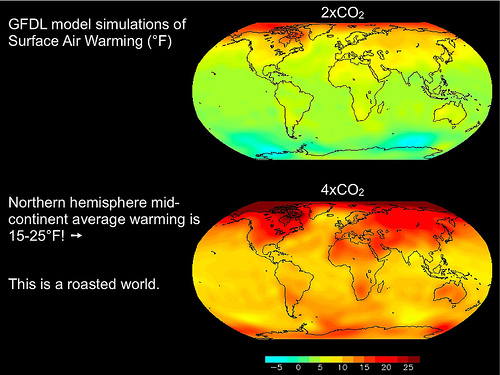
http://www.toddalbert.com/future_warming_depends_on_you
Look at the results of a climate model with both 2X
(top) and 4X CO2 (bottom) by 2100 and ask yourself if anything
can be done.
|
| |
| |
| |
| |
| |
| |
| |

